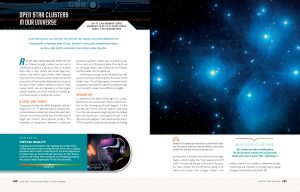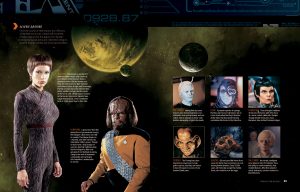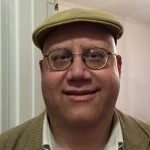
Fifty years ago, when Star Trek first debuted on television, it differed from a lot of other media science fiction in one important way. Gene Roddenberry, the show’s creator and executive producer, wanted it to be as intelligent as possible. As much as he could, he wanted the show to reflect science as realistically as possible.
As a result, whereas other science fiction shows might have made up names for stars and planets, or had spaceships travel from one star to another without worrying about their actual locations, Star Trek strove to be correct. Throughout its travels, the Enterprise and other vessels would encounter stars, planets, asteroid, comets, and nebulae that were scientifically accurate and in some cases really existed.
Andrew Fazekas, the science writer, broadcaster and lecturer also known as the Night Sky Guy (see https://www.thenightskyguy.com), has just published a book that aims to connect the Star Trek fan with the real universe. Star Trek: The Official Guide to Our Universe: The True Science Behind the Starship Voyages is a colorful hardcover delight published in June by National Geographic and retailing for $24.95. The book includes a foreword by his fellow Canadian William Shatner, whom you may have heard of, as he won two Emmy Awards for playing the character Denny Crane. And, oh yes, he originated the role of Captain James T. Kirk.
Throughout the book, Fazekas presents events from Star Trek episodes, explains the science behind them, and provides guides to finding astronomical phenomena in the night sky. For example, in a section on alien life, Fazekas introduces the concept by citing the episode “The Trouble with Tribbles,” next discusses the necessary conditions for alien life to develop on a planet, and then finally guides the reader to find the star Tau Ceti in the sky, as it might have habitable planets orbiting it.
Author Andrew Fazekas was delighted to answer questions from Apex Magazine.
APEX MAGAZINE: How did you get interested in Star Trek?
ANDREW FAZEKAS: With Star Trek it really is something that goes back to my childhood. Some of my earliest recollections were watching the reruns of the original series in the 1970s. I was born and grew up in Montreal, Canada, so I got to see that series with my dad. Sunday mornings we would watch Star Trek together and all those cosmic adventures that they would go through.
AM: How did you get interested in astronomy?
AF: My father is a research scientist and medical doctor. I grew up with him introducing me to all the different types of science, being outdoors, stargazing, fishing, and camping. I was always able to ask him questions. He saw that when I was five and six years old, I was asking him questions about spaceships going on intrepid voyages to weird destinations. So he went out and got a telescope. It allowed us to take our own voyages across the night sky, we would go up to the rooftop of this 14-story building and set up the telescope and he would put me on his lap.
AM: So your interest in Star Trek is directly connected to your interest in astronomy?
AF: Yes! The idea of watching Star Trek and watching the stars through a telescope really went hand in hand. Some of my earliest memories are sitting on my dad’s lap and seeing the moons of Jupiter, the rings of Saturn, and the craters on the moon.

Page 190-191
To view a full sized version visit https://bit.ly/28VTJU5
AM: Can you tell us more about this connection between Star Trek and astronomy?
AF: It’s just a natural connection between these two different worlds. Star Trek particularly has this amazing ability to speak to this deep-seated feeling people have of wanting to explore the unknown. Star Trek speaks to anyone who is a space nerd or a science nerd. It takes science very seriously. They have science consultants on their team when they developed all the series throughout the decades.
For a person like me who is a scientist and science educator it speaks to me. Science fiction in general is an expansion of reality. We have the real world around us but we yearn to explore the unknown. Humans are an amazing species in that we have the ability to use our imagination to take reality to the next level. Star Trek brings that excitement to people.
AM: How did you come up with the idea of writing a guide to the universe by using Star Trek?
AF: Over the years I’ve been a Star Trek fan but I’ve also been an astronomy educator and communicator. Going back many decades I’ve been doing educational workshops and stargazing parties for all age groups. I take my telescopes out under the stars and show people different things happening under the sky, including meteor showers and eclipses. I’ve always tried to make connections to people that they could relate to, as astronomy can be very daunting to some people. I wanted to bring astronomy down to Earth and show how amazing he cosmos is without needing to dumb down or use science jargon.
I had already been a writer and I was looking for an idea for a book project to do. One of the ideas was to do a guide book but there were already so many astronomy guide books out there. How could I do something different? I realized that I could showcase objects that I had seen in Star Trek, be they a supernova remnant, a double-star system, or something else. I could show them the counterpart to that fictional object, and they would remember seeing it from an episode.

Pages 94-95
To view a full sized version visit https://bit.ly/28Sb7nz.
AM: Does Star Trek showcase a lot of real astronomical objects? How real is the Star Trek universe compared to our universe?
AF: There are tons of real life objects. Either the actual objects in the episodes really exist, or there are real-life counterparts that are part of the universe.
AM: So how did you get from conceiving of the book to actually writing and publishing it?
AF: I thought of this idea and wrote out a synopsis ten years ago. I was a full-time freelance science writer, a starving writer, and I was trying to get these book ideas out there. I write mostly new stories for online and print outlets. Writing a book proposal is a big affair that takes a long time. You have to make your case for your book, but I had only a synopsis. The plan was to write a full proposal and then pitch it to different publishers.
However, life happens. We had our first child and fourteen months later we had our second child. As I was working from home, I couldn’t fathom the idea of pitching my idea and writing a full-blown proposal. I couldn’t afford the time to dedicate to this kind of writing. I said I would tuck it away and when my children got older and I don’t have babies running around my house I could spend the time on this it needs.
But at the same time I became a regular columnist with National Geographic News, writing the Starstruck column online, which has earned a lot of success. Out of the blue, I get a call from the book division asking if I’d be interested in writing a book for them. After fifteen minutes of talking about making my column into a book I said I do have this other idea and I pitched it. Within fifteen minutes the editor was taken with the project.
What we realized very quickly was that in a couple of years it would be the 50th anniversary of this franchise and Paramount would be coming out with a new movie. This was an opportunity like no other. I gave them the synopsis that I had written in my backyard in Montreal from ten years ago.
Paramount loved the project from the beginning and CBS was very enthusiastic. This was the type of the project they had been thinking about for decades. We’re showcasing science in their franchise in such a positive light. The folks at Star Trek opened up the vaults of their archives to our team. We would ask for a screenshot of a certain object and they would try to find a unique representation that hadn’t been seen before in print. It was cool to have that. The access we had was amazing.
AM: What do you hope to accomplish with this book?
AF: I want to get people excited to go out under the stars. My hope is that the fans of Star Trek will pick up the book, find out about the real objects, and go outside to try to find those objects. I’m hoping the book will introduce stargazing as a hobby to where the parents and children can go outside together.
AM: Do you think this book might appeal to people interested in astronomy who are not also Star Trek fans?
AF: I can tell you that there’s a natural fit between these two groups of people. I belong to the Royal Astronomical Society of Canada. I’ve been a member since the age of twelve. There’s never a time when there’s no reference to science fiction or Star Trek. It speaks to anyone who is science-oriented.
AM: Although the Star Trek and real universe information on each topic is presented separately, do you worry that some readers might not be able to distinguish between the fiction and the science?
AF: I’m not really concerned because we made clear the distinction between the two. What’s exciting is how real the Star Trek universe is. Some of the technology used in Star Trek is coming into reality now. Our sidebar “Are we there yet?” looks at beloved technologies from Star Trek and shows how far we’ve gotten with them today.
AM: The book uses photos and references to the original universe and the new movies. Do you have any preference for either version with respect to real science being included?
AF: There is hardcore science involved in all versions, even in the reboot movies. In Star Trek Into Darkness, the Enterprise hides in the upper atmosphere of Saturn’s moon Titan. The folks on the film consulted with Carolyn Porco, the main imager of the Cassini mission to Saturn, for the scene. They rendered the hazy atmosphere and showed how the ship would rise out of the atmosphere. And then you can see Saturn’s rings. And I can take you out to see Saturn in the night sky and you can see those rings for yourself! That always knocks people’s socks off. People think you need a giant observatory but all you need is a telescope. You can actually step outside to your backyard and see them for yourself. That is so cool.
Fans have asked me about the animated series. Even the animated series was true to form. They included a double-star system, Beta Lyra.
AM: What’s your favorite Star Trek series?
AF: I’m very nostalgic, and I have to go back to the original series. There are many science goofs they made because they simply didn’t know as much as we know now. But I love that first series. The original cast and the chemistry they had just draws me in all the time. If a Star Trek episode is on a channel somewhere I cannot help but watch even if I’ve seen it a billion times.
AM: What’s your favorite episode of The Original Series?
AF: I’ve liked “Spectre of the Gun” since I was a child. I love that the main characters are bound together in a traditional western.
I loved “The Trouble with Tribbles.” That’s been a family favorite. My two girls love that episode.
And “The City on the Edge of Forever.” There’s science when Kirk looks up at the stars and shows Edith Keeler one of the stars in the belt of Orion. I could go out and see those same stars. As a kid, when I was into stargazing, I made a connection personally with that episode. It must have stayed with me all those decades. He referenced the real star in Orion’s belt.
AM: Was Shatner happy to help out a fellow Canadian by writing the foreword?
AF: When we agreed to do this project, I said I would love for William Shatner to write the foreword. He is so iconic and his character is Star Trek to me. I pleaded with my publishers. I told them to mention to him that I’m a fellow Montrealer and that we went to the same university - McGill University. They opened up the channels to him and he actually wrote the foreword himself. He was tickled pink to help with a science book.
I grew up with this actor playing this amazing role of an explorer, and then to have him in my book—I’m so proud and honored.
AM: Any final thoughts?
AF: To be able to help people appreciate Star Trek on a new level is very humbling. I’m looking forward to sharing my passion for this and to get people to explore the night sky.










